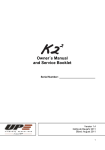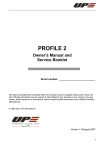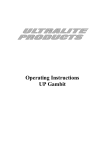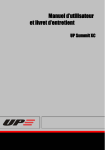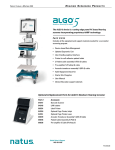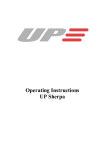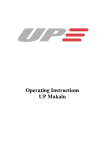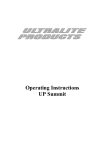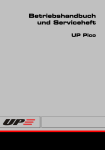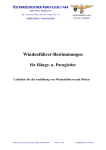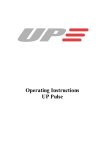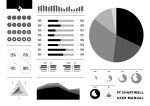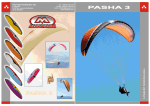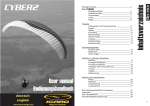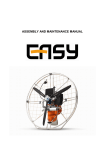Download User Manual UP Teton
Transcript
User Manual UP Teton 1 UP Teton User Manual Version 1.0 Valid from production year 2003 Date: 01.03.2004 2 The data and statements contained within this manual may be changed without prior notice. No part of these documents may be copied or transmitted for any purpose in any manner or by any means, either electronic or mechanical, without explicit written permission from Ultralite Products Europe. © 1995-2004 Ultralite Products Europe 3 Table of contents WELCOME IN OUR TEAM ..........................................................6 SAFETY INSTRUCTIONS .............................................................7 TECHNICAL DESCRIPTION .......................................................8 GENERAL.........................................................................................8 TECHNICAL SPECIFICATIONS ...........................................................9 OVERVIEW....................................................................................10 DIRECTIONS OF USE..................................................................11 ADJUSTMENTS ...............................................................................11 Individual setup ........................................................................11 Adjusting the shoulder straps ...................................................11 Adjusting the chest strap ..........................................................12 Adjusting the lateral chest straps .............................................13 Adjusting the leg straps ............................................................13 Adjusting the leg stirrup ...........................................................13 INSTALLING THE RESERVE PARACHUTE .........................................15 Installing the reserve in the harness.........................................15 Using a front container ............................................................15 Installing the reserve in the integrated reserve container .......16 Safety thread.............................................................................18 Deployment...............................................................................19 COMPATIBILITY .............................................................................20 AIRBAGS ........................................................................................20 Mounting the airbags ...............................................................20 TANDEM USE .................................................................................21 TOWING.........................................................................................21 PARAGLIDER COMPATIBILITY ........................................................22 4 CHECKS, REPAIRS AND FURTHER TIPS..............................23 CHECKS AND REPAIRS....................................................................23 Maintenance and control..........................................................24 Cleaning ...................................................................................24 Packing and checking reserve parachutes ...............................24 Sending the UP Teton and other UP products .........................25 FURTHER INFO ...............................................................................25 UP HOMEPAGE ............................................................................26 ATTACHEMENTS ........................................................................27 5 Welcome in our team Congratulations on the purchase of your new UP Teton harness. With the UP Teton you have chosen a harness that represents the maximum in safety, comfort, functionality and quality in our sport. Please take a little time to complete and send the reply card found in the back of this manual. This way we can keep you informed of all new products and developments at UP, as well as any technical information about the UP Teton. We would also be delighted to hear any feedback you have concerning the harness. It is only through your feedback that we can continue to develop world-class paragliders that appeal to the majority of pilots. If you have any questions regarding your harness or auxiliary equipment please ask your local dealer or feel free to contact us here at UP directly. Your UP Europe Team 6 Safety instructions Paragliding is an extremely demanding sport requiring the highest levels of attention, judgement, maturity, and self-discipline. Due to the inherent risks in flying, no warranty of any kind can be made against accidents, injury, equipment failure, and/or death. This harness is not covered by product liability insurance. Do not use it unless you are personally willing to assume all risks inherent in the sport of paragliding and all responsibility for any property damage, injury, or death, which may result from use of this paraglider. Please read this owner's manual thoroughly before your first flight with the UP Teton so that you are fully acquainted with your new harness. This manual gives you information on the entire specific and general flying characteristics of the UP Teton. It is important to note the following points: • At the time of delivery the UP Teton conforms to German Hang Gliding Association (DHV) requirements (see certification information later in this manual) • Any changes being made outside the permitted range of adjustment invalidate any and all claims under the warranty • Using this harness is exclusively at the risk of the user; the manufacturer or distributor assumes no responsibility for accidents occurring while using it. • The pilot assumes total responsibility for the use of the harness. Before each flight the pilot must perform a mandatory check of the condition of the harness. • It is assumed that the pilot is in possession of the necessary qualifications and that provisions of any relevant laws are observed 7 • When reselling the harness please make sure you also give this manual to the new owner. The manual is an integrated part of the harness and is required to keep its certification. Technical description General The Teton paraglider harness was developed for pilots seeking a sleek, modern harness enabling among other things a greater freedom of movement during launch and landing. A new harness suspension system developed especially for the UP Teton allows a comfortable seated position for thermalling combined with the opportunity to recline to a very efficient supine position for long transitions and gliding accelerated into a headwind. When flying the Teton supine the pilot’s drag is reduced by up to 30% (tested in cooperation with the Porche Enginereering Group in a wind tunnel) to the benefit of min. sink and glide angle. A brief summary of the constructive particularities of the UP Teton: • Special seated/supine suspension system allowing the pilot to assume both a seated position (for thermalling, launching and landing) as well as an aerodynamically more efficient supine position (for gliding and accelerated gliding) • Ergonomically shaped back numerous adjustment options • New reserve parachute container under the seat • “Cobra Compact©” safety clip-in system eliminating the risk of falling out due to un-buckled leg straps 8 support with • Built-in 12cm foam filled airbag • Spacious and aerodynamically shaped rear pocket • Multiple function leg stirrup for relaxing flights and for moving between the seated and the supine position • Lateral fairing • Optional placement of the reserve parachute in the built-in container or in a front container Technical specifications Maximum pilot weight: 100kgs DHV approved back protection: The back protection used in the Teton was developed specifically for this harness. It consists of two separate entities, one standard 12cm foam-filled airbag and one wedge-shaped separate airbag. Both units must be in place for the Teton to conform to it’s certified configuration. Karabiners Powerfly© automatic steel, AustrAlpin Weight: 63 g Load strength: 23 kN Buckles Cobra, AustriAlpin Empty weight (without airbags and karabiners) UP Teton L: 3,5kgs UP Teton M: 3,3kgs 9 Overview 10 Directions of use Adjustments The UP Teton is available in several sizes, thus allowing pilots of different height and girth the pleasure of flying a perfect-fitting harness. The harness can be adjusted within the sizes for different pilot builds. Adjustment buckles are situated on the shoulder straps, the chest strap, down each side from the chest strap, on the leg straps and on the stirrup. The actual adjusting depends on pilot size, preferred flying position and individual preferences Individual setup The first individual adjusting of the Teton is best on the ground before your first flight. Ideally you suspend the harness from a beam via two ropes or straps, or you approach your flying school for the opportunity to hang your new harness while adjusting it. Take your time doing it and always remember to do the adjustments with the reserve parachute installed, and all your normal gear stowed in the various pockets. When performing this initial adjustment on the ground you have got time to get it right and get used to all the different adjustment options before the first flight. This is the ideal way to get it set up for your personal preferences and needs. Adjusting the shoulder straps Shoulder straps are adjusted using the two Kamet© buckles situated on the front of the actual shoulder straps. Factors influencing the chosen setting include pilot height and preferred flying position. To eliminate the slipping off of the shoulder straps always ensure 11 that the connection strap between the two shoulder straps is fastened. When properly adjusted the shoulder straps should sit snug but not tight against the shoulders. The integrated elastic band will maintain snugness even when the straps are not under load, thus eliminating the risk of slipping out due to loose straps. Adjusting the chest strap The chest-strap setting is reset every time you put on your harness and should be adjusted according to personal preferences. A fully open chest strap will allow for very efficient weightshift steering, a tighter setting will feel more stable in the air. We recommend a relatively tight setting in the beginning or until you are familiar with the very efficient weight shifting characteristics of your new harness. The UP Teton comes equipped with the Cobra Compact® safety click-in system. The T-buckle used to fasten the chest strap is connected to a strap coming from beneath the seat plate. This system effectively eliminates the risk of slipping out of the harness in flight due to unfastened leg straps. Notice! When buckling up the Cobra Compact® chest strap components you must hear an audible click coming from each of the buckles as you connect them. Cobra buckles are very difficult or impossible to open when under load. Finally adjust the strap lengths to your personal preferences by pulling or releasing the strap ends. Remember that the tighter the chest strap the less your wing will react to weight shifting. In turbulence the movement of the canopy will also be less noticeable. Notice! A very tight chest strap will increase the risk of twists in extreme situations! 12 Adjusting the lateral chest straps Through the individual setting of the lateral chest strap(s) the flying position is adjusted to fit the preferences of the pilot. Opening the main lateral chest strap will allow for a more supine posture, tightening it will make the flying position more upright. With the secondary lateral chest strap (Kamet® buckle) adjustment it is possible to change the relative height of the rear end of the seat plate. This serves to individually adjust how flat it is possible to lie in the harness. A fully open secondary lateral chest strap will allow for a very flat supine position. Notice! Flying completely outstretched in the harness increases the danger of getting twisted in extreme situations - always remember to curl up in case of collapses to minimize lateral inertia! Adjusting the leg straps The leg strap lengths are reset every time you put on your harness and should be adjusted according to personal preferences. Notice! When buckling up the leg straps make sure you hear and feel an audible click coming from the actual buckles. This is your indication that they are correctly closed. After closing the buckles adjust the length by pulling or releasing the free ends of the straps to your personal preference. They should be snug, not tight, against your thigh. Adjusting the leg stirrup As mentioned above the stirrup allows the pilot to change their flying position during the flight, from 13 seated to supine and back again. Pushing against the stirrup with the feet will change the geometry of the harness by lifting up the rear end of the seat plate, thereby lifting the pilots hips and inducing a more reclined supine position. Pushing the accelerator will have the same effect, but with the stirrup you can chose to fly in the more efficient supine position even when not on speed bar. Notice! Flying completely outstretched in the harness increases the danger of getting twisted in extreme situations - always remember to curl up in case of collapses to minimize lateral inertia! When installing the reserve parachute in the integrated container under the seat (as opposed to when using a front container) it is important to avoid linking the stirrup and the speed bar/accelerator together, as this could obstruct the release of the stirrup when the reserve parachute is deployed (for further reference see the chapter “installing the reserve parachute”). 14 Installing the reserve parachute The UP Teton is built to accept the installation of most common reserve systems available on the market, with a few exceptions! Notice! Using an unsuitable reserve system, or installing a proper system wrongly will seriously compromise your safety in the event of an emergency situation! Should you have questions or doubts regarding the suitability or installation of your reserve system in connection with the UP Teton we strongly recommend that you contact your dealer or UP Europe directly Installing the reserve in the harness The harness reserve bridles are attached to the shoulder straps. To connect these bridles to the reserve bridle we recommend using the “loop-through handshake” knot. This is also the loop knot to use for attaching the deployment handle to the reserve inner container. Notice! Use only the original deployment handle supplied with the UP Teton. Using any other handle could compromise the functioning of the system! Using a front container The UP front container is well suited for use with the Teton harness. Attach the container by connecting the two elastic bands situated on the back of the front container to the main karabiners. Then wrap the two Velcro flaps around the main load-bearing straps running down from the main attachment points. The UP front container is designed to open easily on the 15 left side (click lock and Velcro) to facilitate getting in and out of the harness. The harness reserve bridles run through a Velcro guide on the right side of the front container. Excess reserve bridle is stored at the bottom of the front container in the form of neat S-loops. When using the UP Teton harness with a frontmounted reserve container you can install the optional extra baggage pocket in the integrated reserve container’s place. This means more space for ballast or other equipment that you need when on a flying trip. Installing the reserve in the integrated reserve container The integrated reserve container is located under the seat plate. Six closing flaps provide unrestricted deployment and optional left/right placement of the deployment handle. Notice! When moving the deployment handle from one side to the other be sure to turn the leg stirrup as well! The reserve deployment handle has a 25cm long stiff plastic wire protruding. This wire serves to disconnect one side of the leg stirrup when the reserve parachute is deployed, thereby eliminating the risk of entangling during deployment. When installing the reserve take care to also install the stirrup-release mechanism and test it before flying the harness. We also recommend making this connection part of your pre-flight checking routine. Excess reserve bridle is stored inside the reserve container alongside the inner container. Store it in neat “S” bends! 16 Notice! The following directions must be complied with to ensure the functionality of the system: • When installing inner containers with asymmetrically located attachment points for the deployment handle it is important to turn the inner container in such a way that the deployment handle attachment point is near to the chosen deploying side. This to ensure that when pulling the handle the locking pins are released (see drawing). 17 • Also make sure that the connections from handle to locking pins is always shorter than the webbing going from handle to inner container • When mounting the deployment handle on the Velcro verify that the connections to the locking pins are not completely stretched out. Mounting the handle in a position that stretches the connections to the locking pins will increase the risk of dangerous involuntary deployments! • After installing the reserve parachute always test the deployment system thoroughly before flying. If you are in any way unsure about the correct installation of the reserve system you should always contact your dealer, a professional reserve packer or UP Europe directly. Flying with a improperly installed reserve system will seriously compromise safety in case of an incident. Safety thread DHV (German Hang glider Federation) recommends a minimum deployment force of 5 daN (5 kg applied to the deployment handle in the correct direction), to avoid involuntary deployments. Due to the size and design of the UP Teton integrated reserve container it is however possible that deploying the reserve will require less force than that. Should this be the case we recommend the use of a small piece of cotton thread between the locking pin and the closing loop on the reserve container (see illustration). This is a simple, cheap and efficient way to eliminate involuntary deployments, but always take care to test the system on the ground before flying with it. 18 Notice! The thread, locking pin and the proper installation of the inner container should be checked before each flight. Use only suitable thread – it must not be too strong! Deployment When pulling the deployment handle the first thing to give is the cotton thread. Then the locking pin is pulled out and the outer container opens. The deployment handle is attached to the inner container through the connection strap and allows the pilot to forcefully throw the reserve in the desired direction, away from the main canopy. When installing the reserve system make sure that the deployment sequence is as described here. Any other sequence means danger! 19 Compatibility The installation of the integrated reserve container and the installation of a reserve parachute therein should be approved by the manufacturer of the harness or reserve parachute. This to ensure that the configuration works properly and that all installations have been carried out correctly. After each packing a test release should be done in order to guarantee the normal function of the emergency parachute. The deployment of the emergency parachute must be feasible from each possible flight position. Airbags The UP Teton uses an airbag/foam protector system specifically designed for this harness. The harness is only DHV certified when both protectors are mounted and in place. With the airbag/foam protectors in place the harness passed the DHV 15G shock-absorption test with ease. Furthermore the design of the airbag/foam protector system has an aerodynamic function in that it reduces the harness/pilot drag in flight considerably. Mounting the airbags The UP Teton has two separate bags for the airbag/foam protectors. The primary foam filled airbag is installed through a zippered opening at the bottom of the harness. To facilitate installation a further zipper has been built in, running vertically down the middle of the back inside the back compartment. To install the airbag, open both zippers and slide it into place. Make sure you close both zippers again afterwards. 20 The secondary aerodynamically shaped foam protector is installed through an opening at the bottom of the back pocket. After sliding the foam protector into place it is important that the Velcro closing flaps are properly secured. Tandem use The UP Teton is certified for use as a passenger harness in tandems. Towing The UP Teton is well suited for solo towing. The illustration shows a safe and convenient way of mounting the towline release mechanism onto the harness through a P-link attached to the main suspension points. When mounting the towline release system also refer to the system’s own operating instructions. R iser S ho u lder S trap C arab in e C hest Strap M ain S uspen sio n To w R elease S crew C arab in e 21 Notice! Mounting the towline release system incorrectly could seriously compromise pilot safety! Paraglider compatibility The DHV has stipulated no restrictions in terms of paragliders compatible with the UP Teton harness. The harness is certified in the “GH” category. 22 Checks, repairs and further Tips Checks and repairs The UP Teton harness was developed for long-lasting intensive use. Only the best and most long-lived materials have been used, materials that have proven their worth over years of use in the production of quality paraglider harnesses. However the actual service time that you will get out of your new harness depends to a high degree on the way you treat it! Always beware that the condition of your harness is closely linked to your own personal safety. Check it frequently for signs of wear and have damaged components replaced immediately by UP authorised repair facilities. Take special care to check all structural stitching, i.e. stitching on the structural webbing that constitutes the backbone of the harness construction. Any damaged stitching must be repaired immediately by a UP authorised repair facility. Furthermore you are always welcome to send your harness to UP Europe for checks and repairs! To avoid unnecessary weakening of the UP Teton harness we recommend the following precautions: • Avoid fire and sharp objects near the harness • Avoid unnecessary UV exposure (sunlight). UV radiation affects the molecular structure of the materials used for the harness and will weaken it if exposed for longer periods • Avoid exposure to salt water or acids 23 Maintenance and control The UP Teton harness is maintenance free. Quality in the manufacturing and the use of the best materials available all combine to make this product last long. Regular and frequent checks will guarantee longlasting and unhindered performance. Cleaning Never use strong cleaning solvents when cleaning your harness. Only lukewarm water and, for difficult spots, a mild soap solution. Avoid contact between the soap solution and structural stitching – only use on non-structural parts. Packing and checking reserve parachutes Please remember that only by regularly re-packing your reserve parachute it’s perfect functioning can be guaranteed. As with the paraglider, the reserve should be checked every second year by the manufacturer. Adhere to the packing intervals stipulated by the manufacturer of the reserve system. UP Europe offers a complete service package for reserve systems; checking, packing and installation in the harness, all performed by certified packers. We also repair UP Profile reserve parachutes. 24 Sending the UP Teton and other UP products The best way to send your paraglider, rescue parachute, harness etc. to our service team is in a box via post or UPS. Enclose a note of what requires doing (2 Year Check, repair, repack etc.) and also your daytime contact details. We will return your equipment either by post or UPS. Please indicate preferred method of payment (either bank cheque or C o d)/ Should you require any further information about the services we offer, please contact us at the address and phone number below. We are also able to give you information about your nearest Authorised Service Centre, as well as other manufacturers who are authorised to check and repair UP gliders and equipment. UP Europe GmbH -Abteilung ServiceAltjoch 19A 82431 Kochel am See Germany Email: [email protected] Service Phone: +49 (0) 88 51-92 92 40 Fax: +49 (0) 88 51-92 92 60 Further info Any modifications to the UP Teton harness will invalidate the product guarantee. If you fly often in a salty environment the ageing may be accelerated. We suggest having you harness checked more frequently if this is the case. 25 UP Homepage The UP Homepage gives you information about latest news and products from UP. You will find technical information and accessories for your Sherpa 2, as well as many useful things that necessary for flying. the any UP are Beside paragliders, harnesses and flying equipment you will also find the new “Skywear” collection with the latest flying garments and the “News” section, which will keep you updated with all activities around UP. www.up-europe.com 26 Attachements Reply Card................................................................... 28 DHV certificate UP Teton............................................ 30 27 Reply card Detach card along the perforation and send it to UP Europe! Surname: ________________________________________ First name:_______________________________________ Address:_________________________________________ ________________________________________________ ________________________________________________ Phone: __________________________________________ Fax: ____________________________________________ Email: __________________________________________ UP Teton serial number: ____________________________ bought at:________________________________________ UP Teton checked by: ______________________________ ________________________________________________ My current flying qualification: ______________________ hours:___________________________________________ Paragliding learnt at: _______________________________ Ultralite Products Europe GmbH Altjoch 19 A D-82431 Kochel am See Deutscher Hängegleiterverband e.V. im DAeC DHV/OeAeC-Technikreferat LBA-anerkannte Prüfstelle für Hängegleiter und Gleitsegel Beauftragter der österreichischen Luftfahrtbehörde Herstellerangaben zum Luftsportgeräte-Kennblatt Gleitsegelgurtzeuge (GSG) I. Musterprüfung 1. Gerätemuster: UP Teton L 2. Hersteller: UP Sportartikel Vertrieb Europa GmbH II. Merkmale und Betriebsgrenzen 1. Gurtzeuggruppe: GH 2. Gerätemasse (kg): 3,3 3. Max. zulässiges Anhängemasse (kg): 100 4. Integrierter Rettungsgeräte-Aussencontainer: 5. Gurtzeugprotektor-Muster: ja UP Protec 12 (S) 6 Sonstige Besonderheiten: Zulassung nur in Verbindung mit zusätzlich integrierten Protektor III. Betriebsanweisung in der Fassung vom: 01.11.03 Ort, Datum, Stempel und Unterschrift des Herstellers: Kochel, den 03.11.2003 Bearbeitungsvermerk DHV: Kennblatt geprüft am: von: UP EUROPE GmbH Altjoch 19 A Tel. +49 (0) 88 51-92 92-0 E-mail: [email protected] 82431 Kochel a. S. / Germany Fax: +49 (0) 88 51-92 92-60 www.up-europe.com


































